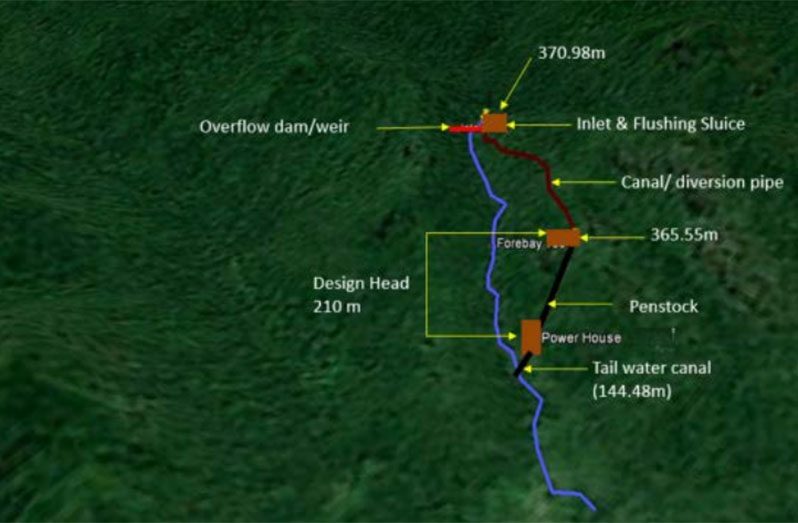–project will also benefit surrounding communities, increase share of renewable energy sources
THE rehabilitation and expansion of the Moco Moco hydropower plant are estimated to cost around US$2.2 million, but, from all indications, the project will contribute significantly to the development of Lethem and other communities in Region Nine (Upper Takutu-Upper Essequibo), by providing reliable and sufficient energy.
The hydropower plant is located along the Moco Moco creek on the Kanuku Mountains, approximately 20 km from Lethem and 500 km from Georgetown.
It was developed in the year 1999, based on an agreement between the Government of Guyana and the People’s Republic of China. But the facility became inoperable in the year 2003 due to a landslide along the penstock alignment (a sluice or gate or intake structure that controls water flow) owing to heavy rainfall.
Cognisant of the impending economic growth and increasing demand for electricity, the Guyana Energy Agency (GEA) and the Hinterland Electrification Company Inc. (HECI), is proposing to rehabilitate the defunct 500 kw hydropower plant to an installed capacity of 700 kw.
In a report submitted to the Environmental Protection Agency (EPA), the GEA and HECI related that rehabilitation of the Moco Moco hydropower plant will create the conditions for Lethem and surrounding villages to benefit from a reliable supply of electricity.
This enhanced energy supply will be delivered through a renewable energy source, which would not generate significant amounts of greenhouse gases.
Additionally, the hydropower plant will increase the share of renewable energy sources within the country’s electrical generation system in the context of sustainable energy development; this is an area of development which the government intends to pursue through its revised Low Carbon Development Strategy (LCDS).
According to the EPA and HECI, the Moco Moco hydropower project is not just sustainable, it is also technically and economically feasible, given its high head run-of-the-river diversion type system.
The new facility will comprise an upgraded installed capacity of 700 kw, which will generate approximately 4,565MWh/yr of energy on an annual basis.
“The structures that were installed included a diversion system, headrace, forebay, penstock, powerhouse, tailwater canal, step up substation, administration buildings and transmission line. As such, the rehabilitation will seek to maintain the current location of the existing hydraulic structure (weir), headrace, forebay, powerhouse, step up substation and tailwater canal,” the energy companies related.
The penstock alignment will, however, be determined when the geotechnical and topographical surveys are completed.
As it is now, Lethem is supplied with power by the Lethem Power Company Inc. (LMPC) on a 24-hour basis. The energy is generated from the company’s six diesel units with a total, installed capacity of 3.825 megavolt amperes (MVA).
Fuel, which accounts for between 60-65 per cent of operational costs, is transported by bulk transportation carriers 450 km from Georgetown to Lethem on unpaved roads, which become very challenging during the rainy seasons resulting in delays in delivery.
And although the generation cost is about US$0.49 kWh, consumers currently pay an average rate of US$0.33 -0.40 per kWh, thus requiring government subsidies in the range of US$500,000 per annum.
“With income at subsistence level, the high cost of electricity supply continues to remain a major burden on the households and businesses, which can only be expected to intensify, considering the expansion of businesses and government’s housing programme in the area,” the EPA and HECI said.
The companies further explained that while the area’s peak demand is 800 kw, this is expected to increase in the short to medium term, particularly since the Government of Guyana has recently completed infrastructural works for an industrial estate in Lethem, which will add to the demand for a more affordable electricity supply
Sitting at the southern end of Guyana, Lethem borders Brazil, which is a known economic powerhouse in South America. The availability of reliable and cheap electricity would, therefore, inevitably draw consumers and developers to Lethem.
ENERGY MIX
It was reported in November last that the government will be tripling the power in Lethem through a revised energy mix.
“We have had a serious review of almost all of the small systems that we have had… we had to look back at what was planned, so we would get 1.5 megawatts from that and we have to rehabilitate Moco Moco, which would be another 0.7 megawatts. So that is 2.2 megawatts and we approved a one-megawatt solar farm…,” Vice-President Bharrat Jagdeo had said.
The aggregate supply of 2.2 megawatts, plus the one megawatt produced by the solar farm would give Lethem three times its current capacity.
“We would have almost triple the capacity and this is all coming from renewable energy, which would allow a massive growth in industrial estates and industrial plants for that area, and also residential purposes.
“If the entire Lethem is running on renewable energy, money is saved; there would be a budgetary balance of payments impact, welfare impact and a business impact,” Jagdeo reasoned.
Given the immense benefits which could stem from reliable and cheap electricity, the Vice-President said the provision of such remains a top priority for the government.
The government recently granted its “no-objection” for the Office of the Prime Minister to engage the China Railway Group Limited to construct the Amaila Falls hydropower station (AFHP) based on a Build-Own-Operate-Transfer (BOOT) model.
Previous reports suggest that the Amaila Falls Hydropower Project (AFHP) is expected to cost just under US$1 billion, and once operational, will have the capacity to generate 165 megawatts of stable and reliable electricity for 11 solid months of the year, with the 12th month during the dry season earmarked for scheduled maintenance.
Currently, GPL sells electricity to the nation around US$0.33 per kWh, and this is expected to be reduced by 25 per cent within the first year of operation of the Amaila Falls project, and by 50 per cent within five years.
The government, in its invitation for bids, had said that it expects the country’s power demands to be met by 2026.



.jpg)











